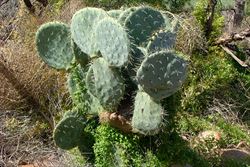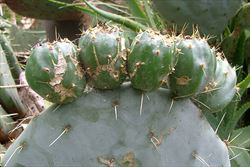Click on images to enlarge

habit (Photo: Sheldon Navie)

habit (Photo: Sheldon Navie)

stem segments with numerous white spines (Photo: Sheldon Navie)

bluish-green stem segments with very few spines (Photo: Sheldon Navie)

close-up of spines (Photo: Sheldon Navie)

immature fruit (Photo: Sheldon Navie)

close-up of immature fruit (Photo: Rob and Fiona Richardson)

mature fruit (Photo: Ros Shepherd)
Scientific Name
Opuntia robusta Wendl.
Synonyms
Opuntia guerrana Griffiths
Family
Cactaceae
Common Names
silver dollar, silver dollar cactus, silver dollar prickly pear, sweet purple cactus, wheel cactus, wheel pear
Origin
Native to Mexico.
Naturalised Distribution
Widely naturalised in south-western Australia (i.e. western New South Wales, western and central Victoria, and south-eastern and eastern South Australia).
Habitat
A weed of semi-arid, arid, and sometimes also warmer temperate regions. It most commonly infests pastures, granite outcrops and open woodlands.
Habit
An upright (i.e. erect) and fleshy (i.e. succulent) shrub usually growing 1-2 m tall, but occasionally reaching up to 4 m in height.
Distinguishing Features
- an upright and fleshy shrub growing 1-4 m tall with much-branched stems consisting of a series of flattened fleshy segments.
- these bluish-green stem segments are almost circular in shape and up to 40 cm across.
- they are covered in raised bumps which bear small bristles and 1-12 sharp spines (up to 5 cm long).
- its showy yellow flowers (5-8 cm across) are borne singly along the upper margins of the stem segments.
- its large fleshy fruit (7-8 cm long and about 6 cm wide) turn pink to purple as they mature.
Stems and Leaves
The stems are much-branched and consist of a series of flattened fleshy segments that are sometimes confused for leaves. These segments are bluish-green in colour (i.e. glaucous) and almost circular (i.e. orbicular) in shape (mostly 20-25 cm across, but occasionally up to 40 cm across). They are hairless (i.e. glabrous) and covered in small raised bumps (i.e. areoles) which bear small bristles (i.e. glochids) and 1-12 sharp spines (up to 5 cm long).
The leaves are reduced to tiny cylindrical (i.e. terete) or cone-shaped (i.e. conical) structures. These leaves are quickly shed from the plant (i.e. they are caducous).
Flowers and Fruit
The large flowers (5-8 cm across) are yellow and occasionally have reddish-coloured streaks on the outer 'petals' (separate male and female flowers are often produced). They are borne singly on fleshy bases along the upper margins of the circular stem segments and have large numbers of 'petals' (actually petal-like structures known as petaloids). Flowering occurs mostly during late spring and summer.
Immature fruit are green in colour, but they turn pinkish to purplish in colour as they mature. These large fruit (7-8 cm long and about 6 cm wide) are fleshy (i.e. succulent), barrel-shaped or rounded (i.e. globose), and have several tufts of tiny barbed bristles (i.e. glochids) on their surface. The dark red coloured pulp in the centre of the fleshy fruit contains large numbers of seeds (3-5 mm across). These seeds are generally light or dark brown in colour and rounded in shape.
Reproduction and Dispersal
This species reproduces by stem fragments (i.e. stem segments easily become dislodged and produce roots) and also by seeds.
Stem fragments are spread by becoming attached to animals, footwear and vehicles and are also dispersed in dumped garden waste. The fruit are eaten by various animals (e.g. birds and foxes) and the seeds spread in their droppings.
Environmental Impact
Wheel cactus (Opuntia robusta) is regarded as an environmental weed in Victoria and South Australia. It was recently listed as a priority environmental weed in four Natural Resource Management regions.
Legislation
This species is declared under legislation in the following states and territories:
- New South Wales: Class 4 - a locally controlled weed. The growth and spread of this species must be controlled according to the measures specified in a management plan published by the local control authority and the plant may not be sold, propagated or knowingly distributed (throughout the entire state). This declaration also applies to all prickly pears (i.e. Opuntia spp.), except Indian fig (i.e. Opuntia ficus-indica).
- Northern Territory: B - growth and spread of this species to be controlled (south of 18°S latitude, in areas outside of towns), and C - not to be introduced into the Territory. This declaration also applies to all prickly pears (i.e. Opuntia spp.).
- Queensland: Class 2 - landowners must take all reasonable steps to keep land free of this species (throughout the entire state). It is also illegal to sell a declared plant or its seed in this state. This declaration also applies to all prickly pears (i.e. Opuntia spp.), except Indian fig (i.e. Opuntia ficus-indica).
- South Australia: 1@ - this species is declared under Class 1c, a classification for prohibited terrestrial plants. It is declared, and its control is required, throughout the entire state. This declaration also applies to all prickly pears (i.e. Opuntia spp.), except Indian fig (i.e. Opuntia ficus-indica).
- Victoria: P3 - prohibited and must be eradicated or controlled (in the Mallee, Wimmera and East Gippsland regions), and C2 - all reasonable steps must be taken to control the weed and prevent its spread (in the North Central and North East regions).
- Western Australia: P1 - the movement of this species or its seeds is prohibited (for all local authority areas in that part of the state north of the 26th parallel of latitude), P2 - to be eradicated (for all local authority areas in that part of the state north of the 26th parallel of latitude, except for the Exmouth, Carnarvon, Murchison, Upper Gascoyne and Shark Bay local authority areas), and P4 - it must be 'contained' (in the Exmouth, Carnarvon, Murchison, Upper Gascoyne and Shark Bay local authority areas). This declaration also applies to all prickly pears (i.e. Opuntia spp.).
Management
For information on the management of this species see the following resources:
- the Biosecurity Queensland Fact Sheet on prickly pear identification and control, which is available online at http://www.dpi.qld.gov.au.
- the Northern Territory Department of Natural Resources, Environment and The Arts Agnote on this species, which is available online at http://www.nt.gov.au/weeds.
Similar Species
Wheel cactus (Opuntia robusta) is very similar to several other related species including drooping tree pear (Opuntia monacantha), white-spined prickly pear (Opuntia streptacantha), common prickly pear (Opuntia stricta), Indian fig (Opuntia ficus-indica) and velvety tree pear (Opuntia tomentosa). These species can be distinguished by the following differences:
- wheel cactus (Opuntia robusta) is a short shrub or tree-like plant (usually 1-4 m tall) with flattened and almost circular (i.e. orbicular) stem segments. It has relatively large yellow flowers (50-80 mm across) and purplish or pinkish coloured fruit. The spines on its stem segments are brownish or greyish in colour.
- drooping tree pear (Opuntia monacantha) is a relatively tall shrub or tree-like plant (usually 2-5 m tall) with flattened and elongated (i.e. oblong or obovate) stem segments (usually 10-30 cm long). It has relatively large yellow flowers (30-60 mm across) and reddish-purple coloured fruit. Some of its relatively thin stem segments (usually only 4-6 mm thick) droop towards the ground during fruiting.
- white-spined prickly pear (Opuntia streptacantha) is a relatively tall and sometimes tree-like shrub (usually 2-4 m tall) with flattened and egg-shaped (i.e. obovate) to almost circular (i.e. orbicular) stem segments. It has relatively large yellow flowers (70-90 mm across) and dull red or yellowish coloured fruit. The numerous spines on its stem segments are whitish in colour.
- common prickly pear (Opuntia stricta) is a low-growing shrub (usually 50-100 cm tall) with relatively large flattened and elongated (i.e. oblong, elliptic or obovate) stem segments (up to 30 cm long). It has relatively large yellow coloured flowers (60-80 mm across) and reddish-purple fruit.
- Indian fig (Opuntia ficus-indica) is a short shrub or tree-like plant (usually 1.5-3 m tall) with very large flattened and elongated (i.e. oblong, elliptic or obovate) stem segments (30-60 cm long). It has relatively large yellow coloured flowers (70-90 mm across) and red fruit. It rarely has any spines on its stem segments.
- velvety tree pear (Opuntia tomentosa) is a tall shrub that is tree-like in appearance (up to 6 m tall) with flattened and elongated (i.e. oblong or elliptic) stem segments. It has relatively large orange-red coloured flowers (40-50 mm across) and red fruit. Its stem segments are velvety in nature (i.e. finely pubescent).

